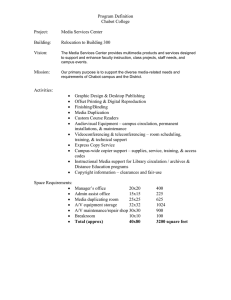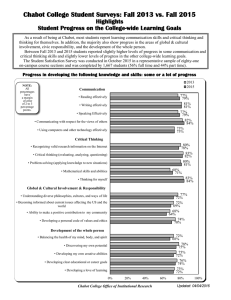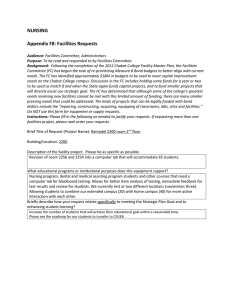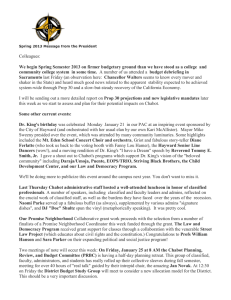PROGRAM REVIEW FINAL REPORT BUSINESS DISCIPLINE June 2008
advertisement
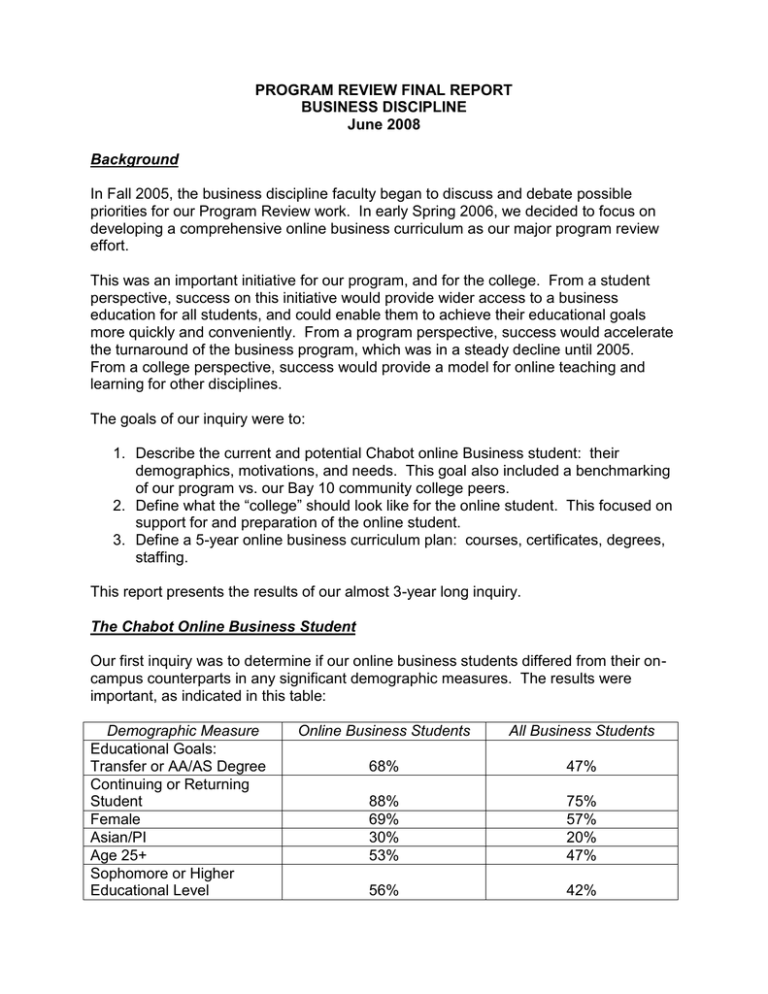
PROGRAM REVIEW FINAL REPORT BUSINESS DISCIPLINE June 2008 Background In Fall 2005, the business discipline faculty began to discuss and debate possible priorities for our Program Review work. In early Spring 2006, we decided to focus on developing a comprehensive online business curriculum as our major program review effort. This was an important initiative for our program, and for the college. From a student perspective, success on this initiative would provide wider access to a business education for all students, and could enable them to achieve their educational goals more quickly and conveniently. From a program perspective, success would accelerate the turnaround of the business program, which was in a steady decline until 2005. From a college perspective, success would provide a model for online teaching and learning for other disciplines. The goals of our inquiry were to: 1. Describe the current and potential Chabot online Business student: their demographics, motivations, and needs. This goal also included a benchmarking of our program vs. our Bay 10 community college peers. 2. Define what the “college” should look like for the online student. This focused on support for and preparation of the online student. 3. Define a 5-year online business curriculum plan: courses, certificates, degrees, staffing. This report presents the results of our almost 3-year long inquiry. The Chabot Online Business Student Our first inquiry was to determine if our online business students differed from their oncampus counterparts in any significant demographic measures. The results were important, as indicated in this table: Demographic Measure Educational Goals: Transfer or AA/AS Degree Continuing or Returning Student Female Asian/PI Age 25+ Sophomore or Higher Educational Level Online Business Students All Business Students 68% 47% 88% 69% 30% 53% 75% 57% 20% 47% 56% 42% Resident of “Other Local Cities: 22% 14% Source: Fall 2005-Spring 2006 Institutional Research Data. Simply put, our online students were predominantly female, older, and more educationally focused and committed than our on-campus students. Our hypothesis is that these students are trying to find ways to complete their education while managing their lives, and the convenience of online classes is enabling them to do just that. We then surveyed all of our online business students in seven sections in Fall 2006 to learn a bit more about who they are, and to better understand their motivations for taking the course online. Again, the results were illuminating, as illustrated below: Why taking the course online? 73% work schedule, 49% family obligations, 30% more comfortable studying at home. Would you have taken the course at Chabot this semester if not offered online: 43% said no. What is your employment status? 63% work full-time How many online classes have you previously taken? 74% had previous online learning experience. What type of Internet connection do you have? 92% had high-speed access. As one of our goals was to increase the enrollment in business courses, this data provided an indication that we were attracting students who would not otherwise have enrolled in a Chabot campus class. To test this hypothesis, we conducted a “business online course cannibalization study”. We looked at total FTES in 6 specific courses for which we had added 17 online sections from Summer 05-Spring 06 to Summer 06Spring 07. The results indicate that adding online sections, or even replacing some campus sections with online sections, does not just cannibalize on-campus enrollments, but actually increases overall enrollment. Course 1A 1B 10 12 16 22 Summer 05-Spring 06 Summer 06-Spring 07 Online HeadOnline HeadSections Sections count Sections Sections Count 17 2 628 18 5 749 6 1 211 8 3 301 9 2 336 10 4 419 12 2 491 16 3 555 7 2 255 9 4 354 4 0 136 4 2 174 Growth EnrollSections ment +6% +19% +33% +43% +11% +25% +33% +13% +29% +39% 0 +38% Finally, to determine how we were doing vs. our Bay 10 counterparts, we compared our online business offerings with each of these colleges. At that time (Summer 06), we had the fourth largest business curriculum in the Bay Area, behind Diablo Valley College, DeAnza College, and Foothill College. These very well-regarded colleges had determined that online offerings were appropriate for their students, and that provided us with encouragement, as well as further guidance on which particular courses might do best online. Services for Online Students We also wanted to explore the services online students would need to be successful in our courses. We asked our students when we surveyed them in Fall 2006, and the primary response was “offer more classes”! We looked at what other colleges were doing, particularly on their business discipline websites, and found that there were no “best practices” available from which we could learn. We knew from secondary research that on-campus orientations might improve retention in our classes, so we began offering those orientations in Fall 2005, and have continued them to date. We offered 6 sessions each semester, led by our full-time faculty, and continued that through Fall 2007. In Spring 2008, the entire campus adopted this model, and Chabot now offers on-campus orientations for online students in ALL disciplines, scheduling 10-12 sessions per semester, plus 2 in the summer. These sessions have been well-attended, and anecdotal feedback is quite positive. This Spring, we revamped our business website, with the goal of providing much more comprehensive information to all of our students, but particularly to our online students. Since we know that our online students may not often (if ever) come to campus, we now include textbook information on the website so they can order their books online. We need to continue to push the college to make the college website more user-friendly, and more comprehensive, for all of our online students. Much work remains to be done to provide the full array of student services to our online students, and we are particularly interested in online tutoring and online counseling. We have piloted some learning assistant projects in our online classes, but without a synchronous, visual methodology, it is very difficult to replicate the value of the oncampus tutoring experience. We look to the college to provide these services to all online students. The Chabot Online Business Curriculum Given our learning about our online students and their needs, and the potential for significant enrollment growth with online classes, we’ve defined our 5-year online curriculum plan as follows: 1. We believe all of our courses can be successfully offered online, and plan to offer all of them online. 2. We will develop courses in specific areas that are only offered online. These are courses that meet clear community needs, but that would be difficult to fill if offered on campus. Our BUS-50 series of 1-unit courses is an example. These business skills classes are designed to offer a quick refresher or rapid, very focused learning about topics that are most relevant to those in the business world today, and are only offered online. Topics include listening skills, supervisory skills, resumes, negotiating skills, business etiquette, and more. We 3. 4. 5. 6. currently successfully offer a dozen of these courses, and have 3 more in development. None of these classes are required for a certificate or degree or for transfer, so we’re comfortable offering these only online. We plan to have all of our certificates available online within the next few years. Our Management and Marketing certificates are already available online, and the others should be available online in Fall 2009. Courses that are required for transfer, a certificate (see exception below), or a degree will be offered both on campus and online. If students are uncomfortable with online learning, they will have all the courses they need to take available on campus. We do plan to develop one new fully online certificate in Health Care Management, and the new courses developed for this certificate will not be available on-campus unless demand is unexpectedly high. Our goal is to offer all of our degrees fully online, but that is a goal that can only be accomplished through the initiatives of faculty in other disciplines, particularly in Math, Economics, and Speech. A challenge as we build this comprehensive online business curriculum is to ensure that we have faculty that are interested in and skilled at teaching online. Six of our seven full-time faculty now teach at least two courses online every semester. We’ve recruited and mentored nine adjunct faculty that are currently teaching online for us, and must continue those recruitment and mentoring efforts. So, What Have We Learned? Throughout this process, we’ve learned that students have much to tell us. They’ve told us they need the option of online learning if they’re to complete their educational goals in a reasonable time, given their complex and busy lives. They’ve told us that they like our offerings, as indicated by the very significant enrollment growth and the always full online sections. What they have not yet been able to tell us is if their learning in our online courses is equivalent to that they would receive in an on-campus course. As we continue to develop our Student Learning Outcomes and rubrics, we will finally answer this question. We hope to begin assessment in our BUS-1A course this fall with a common assessment tool and rubric, and to compare learning in our online and our oncampus sections. We have learned that it is challenging to get the needed focus on student services for our online students. Online learning is still such a new concept to so many at Chabot, and the pathways to providing robust student services aren’t clear. Our administrators and classified staff have very little time and almost no money to work on the new initiatives required to truly provide all services to online students that we provide to our on campus students. However, there are some signs of progress. Although it’s outside the scope of this program review, the college has recently expanded Blackboard support for students, has upgraded the Blackboard system, has adopted a method of evaluating online courses, and is at least beginning the discussion about online counseling and online tutoring. We have learned that, at least in our discipline, our initial forays into online teaching quickly accelerated into a full-blown online curriculum. The faculty received positive feedback from students, encouragement from administrators impressed with the enrollment growth, and took on the challenge of learning to teach well online. In Fall 2008, we will offer 29 fully on-campus sections of business classes, 5 hybrid online sections, and 32 fully online sections. We’ve passed the “tipping point”, and have fully embraced online learning in our discipline. It is still difficult to assess the impact of our work on student learning, but we are confident that we now know the answer to the question of whether online classes enhance student access. And, after all, without access, there is no possibility of learning. We began this program review in Fall 2005. In that academic year (Fall 05Summer 06), with our 13 online sections and 87 on-campus sections, 376 FTES were enrolled in our business classes. In the current academic year (Fall 07-Summer 08), with our 61 online, 7 hybrid online, and 65 on-campus sections, we anticipate 568 FTES, an increase in our enrollment of 51%. This does not reflect growth in the population in our service area, or growth of the college overall. This must be primarily attributed to providing much more convenient access to desired college level business classes for students that would otherwise not be attending college, or not be attending Chabot, or would be taking fewer courses each semester. In retrospect, we perhaps could have focused more on assessment. It would be nice to have end-of-semester feedback from students about their online learning experiences. It would be helpful to have feedback on the value of our on-campus orientations. As we continue to develop our online curriculum, we’ll continue to discuss ways to make our courses more consistent for students without impinging on academic freedom. We’ll develop methods to better market our programs. We’ll continue to work on our website, and to encourage the college to make the website more user-friendly for online students. We’ll continue to discuss ways to improve retention in our online courses—a college-wide goal we share. We’ll encourage the college to fully embrace online student services. We’ll share our learning with our colleagues in other disciplines.
